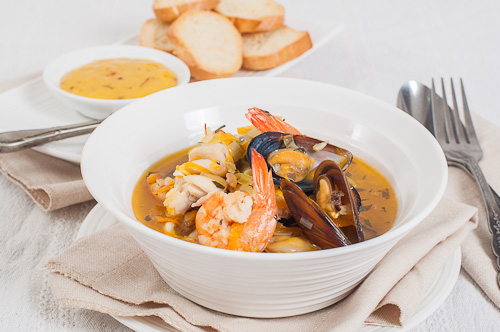There’s something magical about a steaming bowl of bouillabaisse – a dish that evokes the sun-drenched shores of Provence even during the chilliest days of winter.
This iconic fish stew, brimming with fragrant herbs, saffron and the bounty of the Mediterranean, has a history as rich as its flavour.
Bouillabaisse originated in the bustling port city of Marseille, where fishermen needed a way to make use of the less marketable parts of their daily catch. The name itself comes from the Provençal words bolhir (to boil) and abaissar (to simmer), describing the two essential steps in its preparation. These humble beginnings shaped a dish that was as practical as it was delicious, made by boiling rockfish – those tough, bony species unsuitable for sale – with aromatics and herbs to create a hearty, warming stew.
As Marseille grew into a thriving port, bouillabaisse evolved, absorbing influences from the many cultures that passed through its harbours. Saffron, a key ingredient today, was introduced by traders from the Middle East. Tomatoes and potatoes arrived later, thanks to the Columbian Exchange, adding colour and body to the dish. What began as a humble fisherman’s meal became a culinary symbol of the region, celebrated for its bold, aromatic flavours and deep connection to the sea.
Traditionally, bouillabaisse is not just a meal but an event. It’s prepared with care, served in two stages, and best enjoyed in good company. First comes the broth, rich and saffron-hued, ladled over slices of toasted bread slathered with rouille – a garlicky, paprika-spiced sauce. Then, the fish is presented, often a mix of species like red mullet, gurnard and scorpionfish, cooked gently in the broth to retain their delicate textures.
Regional variations have added to bouillabaisse’s appeal, showcasing the diversity of coastal France. In Nice, for example, tomatoes play a more prominent role, while along the Côte d’Azur, chefs may use luxury ingredients like lobster or langoustines to elevate the dish. Even the rules to what constitutes an ‘authentic’ bouillabaisse are fiercely debated. In 1980, chefs in Marseille formalised a charter to define the dish’s preparation, ensuring its heritage remained intact even as it gained international fame.
Bouillabaisse’s reputation as a winter warmer makes it especially fitting for February. The hearty, nourishing qualities of its rich broth and the comforting ritual of dipping bread into rouille create an antidote to the season’s chill. Its communal nature – a dish meant to be shared – brings a welcome sense of conviviality to the darker days.
Today, bouillabaisse continues to inspire chefs and home cooks alike, evolving while staying true to its roots: a testament to the beauty of simplicity, the importance of community, and the timeless appeal of Provence.







Click here to change your cookie preferences